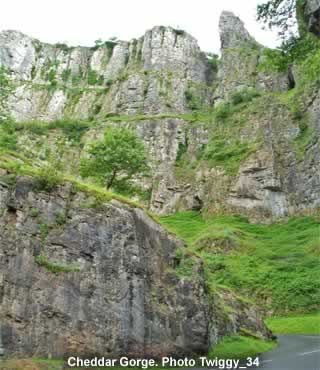Cheddar Gorge |
|
 |
|||
A gaping wound in the land, carved out by river water over the last million years |
||
Listen to this article |
||
The Cheddar Gorge is a gaping wound in the land, carved out by river water over the last million years. Its steep rock faces are the tallest inland cliffs in the country, with a height of up to 137 metres. Beneath these towering giants are a network of caves and caverns. They've been there for nearly an eternity, and the finding of an ancient flint axe shows that humans have been using these caves for a surprisingly large chunk of time. |
||
Archaeology can reveal some interesting things, but it can also discover some discomforting truths. When marks were discovered on animal bones, we knew that the prehistoric people had been cleverly butchering them to dig out their nutritious marrow. Then human bones were found with exactly the same marks. Unfortunately, this proves that the caves' former residents were eating each other! |
||
Thankfully, not all the discoveries made at Cheddar are as gruesome as this. We know that, despite their unsavoury diets, the Stone Age humans were a crafty bunch. They made homes in the shelter of the caves, and made rudimentary tools. They set up ambushes for the animals which were inevitably channelled through the gorge. Much of our knowledge came from the discovery of the “Cheddar Man”, believed to be 9000-year-old, the oldest complete skeleton ever found in Britain. |
||
Finds like this were possible thanks to a Victorian showman called Richard Gough. In 1903, it was he who excavated Cheddar's biggest cavern. His uncle, George Cox, had already made a smaller discovery nearby. Their hard work put the gorge's shadowy secrets on display to the world. |
||
The most spectacular sights are in Gough's Cave. Hundreds of stalactites and stalagmites cling to the floor and ceiling. Their reflections flicker eerily in the water. Cox's Cave is no less atmospheric – in fact, it helped inspire the author J.R.R. Tolkien to write such fantasy masterworks as The Lord of the Rings. Inside, a children's attraction called "The Crystal Quest" recreates a similar world, full of elven magic and evil dragons. |
||
Stories of a less fictional kind are told at the Cheddar Man Museum of Prehistory. As well as the ancient artefacts and hand-on exhibits, they have a replica of the 9000 year old skeleton that revealed so much. Incredibly, DNA testing has proved that one of his true descendants still lives in Cheddar. Somewhat appropriately, he's a history teacher. |
||
Back outside, a fleet of open-top buses take you round tours of the gorge's less claustrophobic sights. You'll see looming limestone, grassy slopes and - if you're lucky - the Peregrine Falcons that have made Cheddar their home. After being underground for so long, you may feel an urge to join the birds, up there in the open sky. You can get a little closer by climbing Jacob's Ladder, a flight of 274 steps carved into the rocky cliff. If the exertion doesn't take your breath away, then the views from the top will. |
||
Of course, the Cheddar area gave its name to the famous cheese, but this is relatively recent news compared to the gorge's prehistoric secrets. People estimate that the local dairy farmers have been making it since the 12th century, but this is still practically yesterday. The tradition is upheld by the Cheddar Gorge Cheese Company, who still mature their products inside the caves themselves. This is the only place in the world where that still happens. |
||
It's impressive that the caverns are so well used, and so popular. Even so, it's like a labyrinth down there, and we'll never be sure if we've uncovered it all. Rumours persist of a "lost cave", hidden somewhere beneath Cheddar's cliffs. We've learned so much from the gorge already, but who knows what secrets it's still hiding. |
||
|
||
Cheddar Gorge & Caves are open daily, 10am to 5.30pm. Entry costs around £17 for adults, £11 children. Cheddar Caves & Gorge, Cheddar, Somerset, BS27 3QF. Tel: 01934 742343 |
||
|
Pocket Britain is optimised for use on a smartphone or tablet with internet access. All content is subject to copyright. All reasonable methods have been used to ensure information supplied is accurate at the time of publication. However, it is advisable to check information before relying on it. Privacy Policy |